2-(3-Nitrophenyl)-1,3-dioxolane [6952-67-6]
1H-NMR

| 1H-NMR: 2-(3-Nitrophenyl)-1,3-dioxolane | |||
| 250 MHz, CDCl3 | |||
| interactive spectrum | |||
| delta [ppm] | mult. | atoms | assignment |
| 4.05-4.18 | m | 4 H | -OCH2CH2O- |
| 5.90 | s | 1 H | O-CH-O |
| 7.54-7.60 | m | 1 H | 5-H |
| 7.79-7.83 | m | 1 H | 6-H |
| 8.20-8.25 | m | 1 H | 4-H |
| 8.35-8.37 | m | 1 H | 2-H |
| 7.26 | CHCl3 | ||
| 10.15 | s | 1 H | CHO (educt) |
13C-NMR |
| 13C-NMR: 2-(3-Nitrophenyl)-1,3-dioxolane | |||
| 250 MHz, CDCl3 | |||
| interactive spectrum | |||
| delta [ppm] | assignment | ||
| 65.5 | -OCH2CH2O- | ||
| 102.3 | -O-CH-O- | ||
| 121.7 | C2 | ||
| 124.0 | C4 | ||
| 129.4 | C5 | ||
| 132.7 | C6 | ||
| 140.4 | C1 | ||
| 148.3 | C3 | ||
| 76.5-77.5 | CDCl3 | ||
IR
| IR: 2-(3-Nitrophenyl)-1,3-dioxolane | |||
| [KBr, T%, cm-1] | |||
| [cm-1] | assignment | ||
| 3093 | arom. C-H valence | ||
| 2978 | aliph. C-H valence | ||
| 2905, 2862 | C-H valence | ||
| 2769 | C-H valence, O-CH-O | ||
| 1621, 1588 | arom. C=C valence | ||
| 1532, 1359 | N=O valence | ||
| 1532, 1359 | N=O valence | ||
Acid catalyzed acetalisation of 3-nitrobenzaldehyde with ethanediol to the correspondent 1,3-dioxolane
 | + |  |
|  | + |  | ; Side reactions |
Acid catalyzed acetalisation of 3-nitrobenzaldehyde with ethanediol to the correspondent 1,3-dioxolane
|
| Reaction type: | reaction of the carbonyl group in aldehydes, acetalisation |
| Substance classes: | aldehyde, acetal, alcohol, protecting group, acid catalyst |
| Techniques: | removal of water by azeotropic distillation, heating under reflux with Soxhlet extractor (for 10 mmol preparation), stirring with magnetic stir bar, evaporating with rotary evaporator, shaking out, extracting, recrystallizing, filtering, heating with oil bath |
Reaction
3-Nitrobenzaldehyde (15.1 g, 100 mmol), ethanediole (6.83 g, 6.20 mL, 110 mmol) and 4-toluenesulfonic acid monohydrate (1.00 g, 5.30 mmol)
 are dissolved in cyclohexane (200 mL) in a dry 500 mL round bottom flask equipped with magnetic stirring bar, Dean Stark trap and reflux condenser. The reaction mixture is refluxed until no more water are dissolved in cyclohexane (200 mL) in a dry 500 mL round bottom flask equipped with magnetic stirring bar, Dean Stark trap and reflux condenser. The reaction mixture is refluxed until no more water  is collected in the Dean-Stark trap (approx. 2-3 h is collected in the Dean-Stark trap (approx. 2-3 h  ). ).Work up
The hot reaction mixture is poured into another 500 mL round bottom flask to separate it from an oily sediment (800 mg) which has formed at the bottom of the reaction vessel. The sediment consists predominantly of product, starting material and 4-toluenesulfonic acid (1H-NMR spectrum). The solvent of the decanted solution is directly removed with a rotary evaporator
 . A yellow crystalline solid remains as crude product. . A yellow crystalline solid remains as crude product.
Crude product yield: 19.7 g; melting point 50-52 °C; Purity according to GC: 95% acetale + 4% aldehyde
In order to remove unreacted aldehyde as hydrogensulfite adduct, the crude product is dissolved in 200 mL tert-butyl methyl ether and extracted once with 20 mL saturated aqueous sodium hydrogen sulfite solution. The organic phase is dried over sodium sulfate, the sodium sulfate is removed by filtration and the solvent is evaporated with a rotary evaporator
 to yield a nearly colorless crystalline residue. to yield a nearly colorless crystalline residue.
Yield: 17.9 g; melting point 57-58 °C; Purity according to GC: more than 99%.
The product is for most uses pure enough. If further purification is required, recrystallization from a solvent mixture of cyclohexane / tert-butyl methyl ether in a ratio of 1:1 (approximately 45 mL) can be carried out. The solution should be allowed to stand covered at room temperature until crystals form (if needed 1 to 2 days). If the solution is cooled quickly in an ice bath, only an oil generally forms. After cooling for a short time in an ice bath, the crystals are filtered and dried until constant mass is achieved in a desiccator at reduced pressure.
Yield: 15.9 g; melting point 57-58 °C; colorless crystals; purity according to GC: more than 99%.
The product can also be recrystallized from a small amount of hot ethanol, however with a much poorer yield.
Duration of the experiment
Approximately 5 hours including work up.
Where can I stop the experiment?
After evaporation of the cyclohexane from the reaction solution.
Recycling
The cyclohexane from the reaction mixture and the tert-butyl methylether are collected and redistilled.
|
Suggestions for waste disposal | ||||||||||||
|
Substances required |
| Educts | Amount | Risk | Safety | ||||||
|---|---|---|---|---|---|---|---|---|---|
| 3-Nitrobenzaldehyde |
| 15.1 g | H302 H411 | P273 | |||||
| 1,2-Ethanediol |
| 6.83 g | H302 | P301 + 312 | |||||
| Catalyst | Amount | Risk | Safety | ||||||
| 4-Toluenesulfonic acid monohydrate |
| 0.19 g | H315 H319 H335 | P261 P305 + 351 + 338 | |||||
| Solvents | Amount | Risk | Safety | ||||||
| Cyclohexane |
| ~ 230 mL | H225 H304 H315 H336 H410 | P210 P233 P240 P273 P301 + 310 P302 + 352 P331 P403 + 235 | |||||
| tert-Butyl methyl ether |
| 230 mL | H225 H315 | P210 | |||||
| Others | Amount | Risk | Safety | ||||||
| Sodium disulfite |
| ~ 13 g | H302 H318 EUH031 | P280 P305 + 351 + 338 P313 | |||||
| Sodium sulfate |
| ~ 5 g | |||||||
| Molecular sieve 4A |
| 0 g | H315 H319 H335 | P261 P305 + 351 + 338 | |||||
| Solvents for analysis | Amount | Risk | Safety | ||||||
| tert-Butyl methyl ether |
| 5 mL | H225 H315 | P210 |
Substances produced |
| Products | Amount | Risk | Safety | ||
|---|---|---|---|---|---|
| 2-(3-Nitrophenyl)-1,3-dioxolane | 17.9 g | ||||
| Water | H- EUH- | P- |
Equipment |
 | round bottom flask 100 mL |  | Soxhlet extractor 30 mL | |
 | extraction cone |  | reflux condenser | |
 | heatable magnetic stirrer with magnetic stir bar |  | separating funnel | |
 | rotary evaporator |  | suction flask | |
 | Hirsch funnel |  | exsiccator with drying agent | |
 | oil bath |
| Waste | Disposal |
|---|---|
| aqueous phase from water separator | solvent water mixtures, halogen free |
| aqueous phase from shaking out | solvent water mixtures, halogen free |
| dissolve residue from reaction flask in a small amount of acetone | organic solvents, halogen free |
| mother liquor from recrystallisation | organic solvents, halogen free |
| sodium sulfate | solid waste, free from mercury |
Simple evaluation indices |
| Atom economy | 91.5 | % | |
| Yield | 93 | % | |
| Target product mass | 1.82 | g | |
| Sum of input masses | 74 | g | |
| Mass efficiency | 24 | mg/g | |
| Mass index | 41 | g input / g product | |
| E factor | 40 | g waste / g product | |
| Energy input | 870 | kJ | |
| Energy efficiency |
|
The classical variant of the "Acid catalyzed acetalisation of 3-nitrobenzaldehyde with ethanediol to the correspondent 1,3-dioxolane" is an easily performed experiment. The desired product is obtained in high yield  and high selectivity. Also the purity of the end product is very high.The mass efficiency is high to medium, compared to the other NOP experiments and thus evaluates as good and high selectivity. Also the purity of the end product is very high.The mass efficiency is high to medium, compared to the other NOP experiments and thus evaluates as good  . The energy efficiency of the classical experiment is highly dependent on the method of heating . The energy efficiency of the classical experiment is highly dependent on the method of heating  . .
(Eco)toxicological data for the educt 3-nitrobenzaldehyde are incomplete, toxicological data for the product 2-(3-nitrophenyl)-1,3-dioxolane have not been determined at all. According to theoretical prediction methods both product and educt are suspected to have mutagenic, carcinogenic and sensitizing properties. The organic solvents used in this experiment ethanol,cyclohexane and tert-butyl methyl ether exhibit relatively low acute toxicity. Also the inorganic auxiliary materials do not pose significant dangers to human health
 . .
Educt, product and the solvents cyclohexane and tert-butyl methyl ether are biologically not easily degradable, and some are classified as dangerous to the environment because of their toxicity to aquatic organisms
 . .
Summed up we evaluate this experiment with a good economic efficiency and acceptable toxicological risks, but a relatively high environmental persistence of the used substances with the "yellow light".
|
Chromatogram |

| GC: crude product | |
| column | Zebron ZB-1, L=15 m, d=0.25 mm, film 0.25 µm (Phenomenex) |
| inlet | injector: 250°C, split injection, 0.15 µL |
| carrier gas | He, pre-column pressure 101 kPa |
| oven | 85°C (0 min), 8°C/min --> 250°C (10 min) |
| detector | FID, 250°C, H2 33.9 mL/min, synth. air 322 mL/min, isocratic N2, 15 mL/min (59 kPa) |
| integration | percent concentration calculated from relative peak area |

| GC: pure product | |
| column | Zebron ZB-1, L=15 m, d=0.25 mm, film 0.25 µm (Phenomenex) |
| inlet | injector: 250°C, split injection, 0.15 µL |
| carrier gas | He, pre-column pressure 101 kPa |
| oven | 85°C (0 min), 8°C/min --> 250° C (10 min) |
| detector | FID 250°C, H2 33.9 mL/min, synth. air 322 mL/min, isocratic N2, flow 15 mL/min (59 kPa) |
| integration | percent concentration calculated from relative peak area |
Bali indonesian food
Balinese cuisine - Wikipedia, the free encyclopedia
https://en.wikipedia.org/wiki/Balinese_cuisine
Balinese foods include lawar (chopped coconut, garlic, chilli, with pork or chicken meat and blood), Bebek betutu (duck stuffed with spices, wrapped in banana leaves and coconut husks cooked in a pit of embers), Balinese sate known as sate lilit made from spiced mince pressed onto skewers which are often lemon grass ...
artofadventuring.com




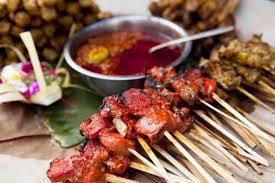



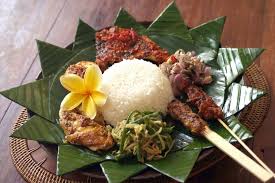

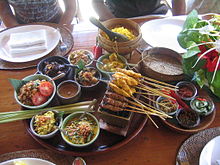
Indonesia is a vast, sprawling island nation in SE Asia with well over13,000 islands. Of Indonesia's dozen or so major islands, Bali, Sumatra and Java are .

Indonesian Foods – 9 Best Meals | EFoodDepot Blog
efooddepotblog.wordpress.com
Gado Gado is a tossed salad mix that usually consists of cut cabbage, watercress, bean sprouts, sliced up cucumbers, fried tofu, cut and also steamed ...
Exploring Bali - Bed & Breakfast - Part 4
bedandbreakfast.blogdetik.com

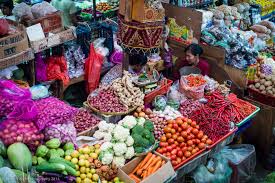
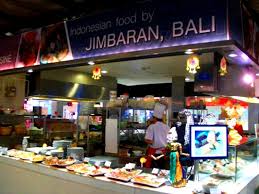

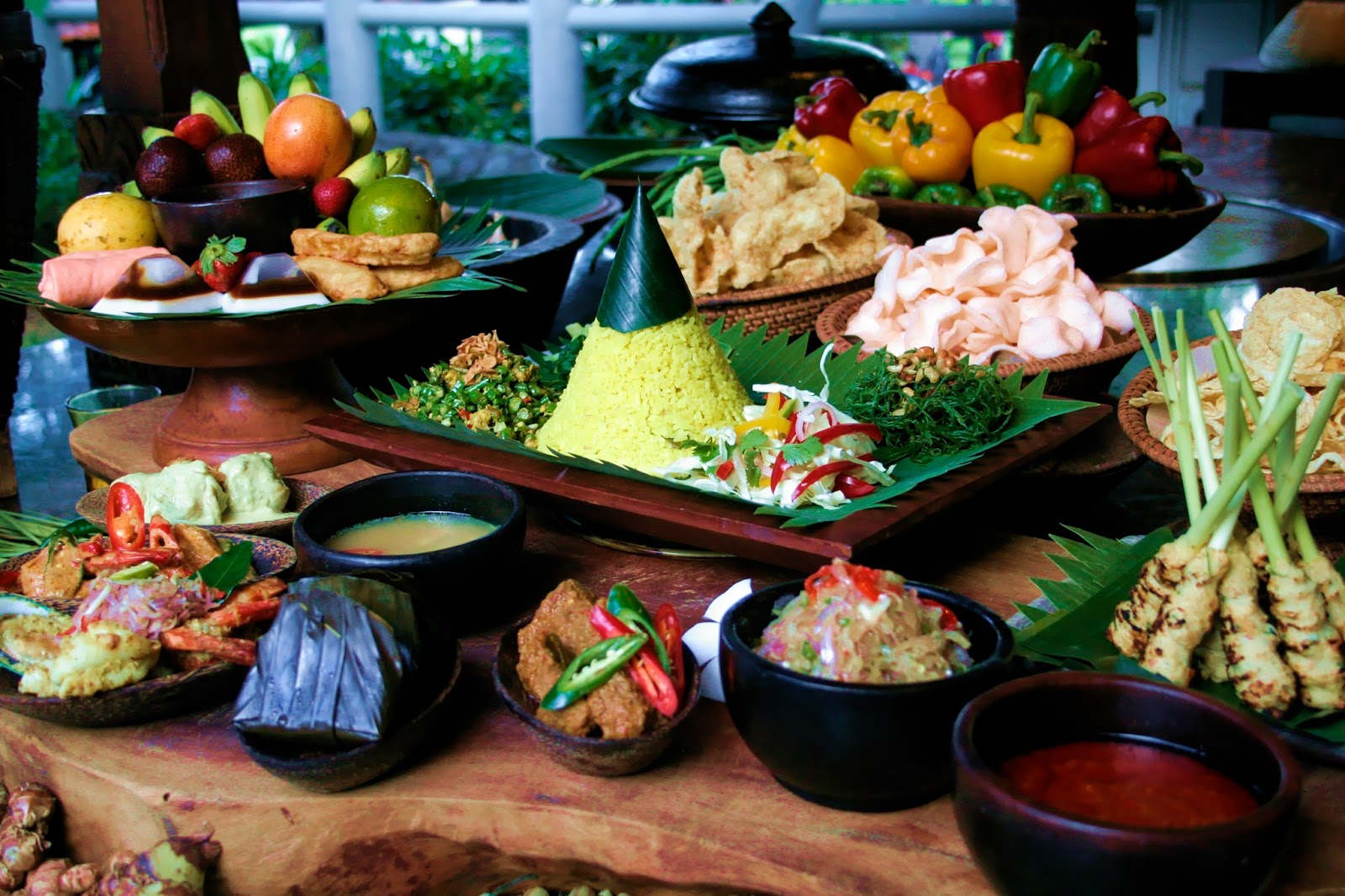



Padang Food or nasi Padang, originally from Sumatra, Padang. it's beef cooked with indonesian spices, lots of chili ” not really spicy”, coconut milk. they ...


Top 10 Best Bali Food
- Thousands of islands with different cultures make up Indonesia, so no wonder its food is just as diverse. To complement the holiday experience on Bali, you would not want to miss out on its assortment of dishes.These include interesting and exotic selections such as 'lawar', 'bebek betutu', the Balinese satay version known as 'sate lilit', and the island’s famed 'babi guling' whole spit-roast pig. The Balinese have a rich collection of snacks, cakes and desserts for your sweet tooth too!
- 1Sate VarietiesSate (or “satay”) are marinated, skewered and grilled meats, served with spicy sauce, and may consist of diced or sliced chicken, goat, mutton, beef, pork, fish, tofu, eggs or minced blends. Bali’s own variant is sate lilit, made from minced beef, chicken, fish, pork, or even turtle meat, which is then mixed with coconut, coconut milk, and a rich blend of vegetables and spices. Wrapped rather than skewered around bamboo, sugar cane or lemongrass sticks then grilled, sate lilit can be enjoyed with or without sauce.2Nasi Ayam and Nasi CampurBali’s own take on ‘chicken rice’, nasi ayam and nasi campur can be found served at many warungs (small eateries) and restaurants throughout the island. The dish is mainly white rice served with many different elements of Balinese delights, from a bit of babi buling or betutu as the main meats, together with mixed vegetables and a dab of the iconic spicy hot sambal matah – sometimes served with a bowl of soup. For those who do not want it too spicy, simply ask for it without the sambal.3Bebek and Ayam BetutuBetutu is an iconic Balinese favourite, consisting of a whole chicken or duck stuffed with traditional spices, wrapped in banana leaves, then enveloped tight in banana trunk bark before it’s baked or buried in a coal fire for 6 to 7 hours. The result is a rich and juicy, succulent feast with all meat easily separated from bones. Betutu is the Balinese slow-cooked luscious equivalent of babi guling for ‘non-pork eaters’.4Babi GulingBabi guling is an all-time favourite, consisting of spit-roast pig stuffed with rich traditional spices and vegetable mixes such as cassava leaves, slowly ‘rolled’ over (hence its name, guling means ‘to roll’) a coal fire. The crisp brown skins are prized, while the meat is a tender and juicy treat. At first the dish was a communal treat only during special festivities and ceremonies, but now babi guling can be found widely served at warungs and restaurants specialising in this dish.5Tahu and TempeAmong the most versatile of food items, tahu (tofu) and tempe come in various preparations, some as savory snacks, and some as accompaniments and even main course dishes. These soy bean curds may be fried, stuffed and battered. Many Indonesian dishes, especially those that have the main portions of rice, include tempe crackers, while the most favourite tahu snack are the stuffed and fried versions which usually include a mixture similar to spring rolls.6Jimbaran SeafoodThe line-up of beachside cafés on Muaya beach in Jimbaran Bay typically serves grilled fresh caught seafood, ranging from shrimp, clams, crabs, calamari, lobsters and a wide assortment of fish. But in terms of taste, the secret lies in each of the café owner’s recipes of barbecue sauce and condiments – usually in the form of homemade sambal, which has collectively become known as “sambal seafood – Jimbaran style”. From sweet-sour blends to the typical hot and spicy... tasting is believing!7Pepes and TumPepes is an Indonesian Sundanese cooking method using banana-leaf as food wrappings. The small package is sewed with thin bamboo sticks at both ends, and either steam-cooked, boiled or grilled. It is most commonly used to prepare fish as “pepes ikan” or meat, chicken, tofu or vegetables. Tum takes on a different form, with the wrapping folded and stitched at one top end, and usually steam-cooked. The banana-leaf wrapping provides a special aromatic appeal to the cooked blend.8LawarLawar is a traditional mix containing fine chopped meat, vegetables, grated coconut and spices. Sometimes, and in some areas, lawar is prepared using fresh blood mixed with the meat and spices to strengthen the flavour. Lawar are usually served immediately after preparation as it cannot be kept long. There are two main types of lawar, white and red. The white version usually does not contain any meats or blood.9Traditional Cakes and DessertsTraditional cakes are collectively referred to as jajanan pasar (traditional market cakes), originally used to accompany ceremonial offerings, but now have found their way to the markets as daily coffee time favourites. The varieties abound, but the ingredients usually include rice flour, glutinous rice, sugar, coconut and tropical fruits. Wajik, pancong, jaja batun bedil, bubuh injin, godoh, pisang rai, and kelepon are typical varieties.10Nasi GorengNasi Goreng is Indonesia's fried rice, one of the nation's most notable dishes. Nasi Goreng is pre-steamed rice stir-fried with a combination of meats and vegetables, ranging from scrambled eggs, diced beef, strips of chicken, shrimp, anchovies, lamb, crab, green peas, onions, shallots and a blend of sweet soy sauce or kecap manis and hot chili sauce. The presentation usually features the typical toppings: sliced tomatoes and/or cucumber, fried shallots, fish or shrimp krupuk crackers and mixed pickles or acar.

Examples of Balinese dishes, such as sate lilit, nasi kuning, lawar, and lala manis sambal condiment
Soto babi, Balinese pork soto
Telur bumbu from Bali (boiled eggs in a hot and spicy sauce)
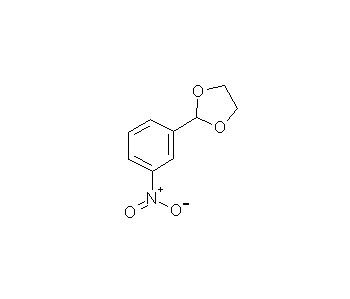
















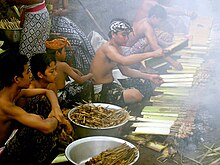
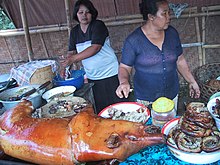




No comments:
Post a Comment